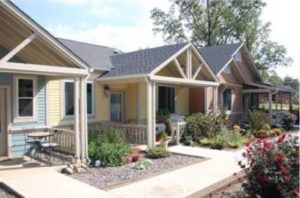AARP Hearing Center
We Must Make Our Communities More Livable for All
By Debra Whitman, May 3, 2017 04:54 PM
This post originally appeared in the IAGG 2017 Bridge blog.

Across the globe populations are aging, and this far-reaching change is happening much faster than most people realize. In just five years, the number of older persons will surpass one billion; they are already a fast-growing presence in cities and towns of all sizes, every region and all segments of society.
Photo courtesy of Dan Burden
This change provides countries across the globe with a great opportunity, because older individuals have so much to offer the communities where they live. But making the most of it will require vision and innovative thinking.
Fortunately, we have a growing body of knowledge about what it takes to make a community more “age friendly.” And it is becoming clearer all the time that cities and towns that embrace this priority are rewarded with a better quality of life for all their residents. There really is no alternative, because demographic trends are transforming societies around the world whether they are prepared or not.
Consider these numbers:
- For the first time in human history, by 2030, the number of people age 60 and over will exceed the number of children age 10 and under, an unprecedented demographic milestone that signals new challenges – and opportunities – for institutions, communities, government and the private sector.
- Our very notion of what it means to be “old” is changing profoundly. A 10-year-old in the United States now has a 50 percent chance of living to age 104. By 2050, the United States is projected to have more than 1 million centenarians.
Nations and local communities that take steps to become more livable for all will have the advantage over those that do not. The good news is that practical models on improving communities to be age friendly are available. Pioneering work by the World Health Organization (WHO) provides many insights into how communities can promote healthy, active aging and support inclusion and engagement that benefits all their residents.
The WHO also sponsors a Global Network for Age-Friendly Cities and Communities that share insights on best practices and lessons learned. AARP is committed to making this information more available, and in 2012 we created the AARP Network of Age-Friendly Communities to further that goal, in affiliation with the WHO.
These age-friendly networks highlight eight domains of livability that help shape quality of life for people of all ages: Outdoor spaces and buildings; transportation; housing; social participation; respect and inclusion; civic participation and employment; communication and information; community and health services.
Importantly, Alexandre Kalache, who helped create the WHO network, points out that age-friendly features do far more than just help seniors, they help everyone. Take the example of a bus that is designed for easy access. “If it is easy for an older person to get in and out of this bus, it is going to be more (accessible) to a child or a teenager, to a pregnant woman or to someone carrying her luggage.”
Design, land use and infrastructure all help pave the way for people to stay engaged in the world around them. But Kalache notes that for a place to be truly age friendly, inclusiveness must become a broadly shared cultural value. As he puts it, such a community is a place “where the attitude is right – from the policymakers to the service providers to the population as a whole…”
Age-Friendly Communities
Promoting the value of inclusion requires a multi-faceted effort. Age-friendly communities should have physical infrastructures and offer services that help residents of all ages live active, engaged and secure lives. They should enact policies and rules (e.g., zoning and land use regulations) that create an accessible built environment and ensure affordable and convenient housing alternatives.
Age-friendly communities should provide transportation options that meet the varied needs of residents, including easy access to health care and retail shopping for basic necessities. They should keep the environment clean and public spaces safe and free of crime.
Age-friendly communities should give residents access to housing that is located near crucial services, such as transportation, health care, retail and recreation. Available housing should include choices that meet the needs of residents of all ages, including families with kids and those with grandparents.
All of these things make it easier for people to live the way they want to. And the fact is that most of us want the chance to age in our homes and communities for as long as possible. AARP surveys consistently show that older people desperately want to hold on to their independence and avoid moving into nursing institutions.
Yet obstacles often stand in the way of living independently and securely, particularly as we get older. Take the basic example of walking safely to the store or strolling around the block. In the United States, adults 65 and older make up 13 percent of the population, yet they suffer nearly 20 percent of pedestrian fatalities. Communities can do better. As a start, they should make changes to street, crosswalk and sidewalk design, maintenance, and signage. Poor infrastructure is also often the cause of older adult falls and falls are the cause of 68 percent of older adults’ hospitalizations.
Engagement, Foresight and Inclusiveness
Importantly, age-friendly places recognize older adults as the community assets that they are. They know that older residents offer experience and perspective that should be taken advantage of when it comes to planning, implementation and evaluation of programs and policies. They understand that in the process, the benefit flows in both directions: Older adults who get involved benefit personally from a sense of purpose and engagement, while the community gets the value of their experience. Inclusion leads to better decisions that help everyone.
An inclusive approach to age-friendly planning also raises awareness of changes affecting communities and the needs of residents. Noteworthy changes include the growing role of grandparents in raising grandchildren, the increase in multigenerational families, and growing ethnic and racial diversity in older age groups. An inclusive approach also seeks out input from a diverse set of older residents who may offer insights and solutions that would otherwise be overlooked. Further, age-friendly planning recognizes that as the population ages, there will be an increasing number of individuals with disabilities who rely on local services to stay independent.
Commitment and On-the-Ground Action
AARP’s goal is to help people live more easily and comfortably as they age and it has been gratifying to see that this goal is widely shared. Since its start in 2012, the AARP Network of Age-Friendly Communities has boomed, with a membership that has now reached 163 localities that are home to more than 64 million people living all over the United States. These are communities of all shapes and sizes – from small towns and rural counties to cities as large as Atlanta, Boston and Dallas.
AARP state offices work with local officials and activists across the network to promote age friendliness, and our communities have shown real leadership to prepare for demographic change rather than passively wait for it.
Within the network, we’ve seen a wide range of programs and successes.
- Portland, Oregon adjusted zoning codes and reduced municipal fees to make it easier for homeowners to add an accessory dwelling unit (or granny-flat), which can help residents to age in place.
- New York City added 1,500 new benches and 3,500 new or improved bus shelters, providing resting places for pedestrians and encouraging bus ridership, particularly in locations where older riders were likely to board.
- Washington, DC engaged over 500 volunteers in a multigenerational block-by-block walk program to identify pedestrian challenges such as broken sidewalks, missing curb cuts, and traffic signals that don’t allow safe crossing. It also introduced a free mobile app so people can report problems directly to transportation officials.
- Macon-Bibb County in central Georgia undertook a series of improvements to Tattnall Square Park, such as numerous resting facilities and a new gateway, in order to make the park more accessible and enjoyable for all.
- Westchester County, New York established a program to coach family caregivers who are often faced with difficult tasks in caring for loved ones who want to remain in the community.
Given the breadth of issues that age-friendliness must address, this work requires a local government commitment from the very top – one that filters down through every department to frontline workers. Age friendliness has to work for everyone, so it is vital that local officials and planners work across silos and reach into other disciplines to find holistic solutions. I am heartened by the extent to which age-friendly awareness is increasingly embraced by disciplines as varied as planning, architecture, real estate development and zoning, as well as increasing examples of cross-sector collaboration.
To support this multi-discipline approach, in March AARP sponsored a Summit on Livable Communities, which brought together two key organizations representing different disciplines – the American Society on Aging and the American Planning Association. The summit included 250 aging network professionals and local/regional planners, who talked about ways to work across professional silos to advance livable communities for all people, regardless of their age or ability. I believe some great partnerships were formed during the event, and look forward to hearing about future accomplishments.
We now know that people of all ages want their communities to be age friendly, whether they live in small villages, big cities or suburbs. The need is growing and not just in the developed world. By mid-century, one in five people in developing countries will be over 60. Communities of all sizes, all stages of development and in all regions of the world will benefit by making age friendliness a priority.
Building on our existing knowledge about age friendliness to find new and more effective approaches should be a priority in communities all over, and AARP is committed to helping.
Across the globe, community leaders cannot afford to ignore their aging populations. Everyone will benefit when we embrace this change and work together to prepare for the future.
































































